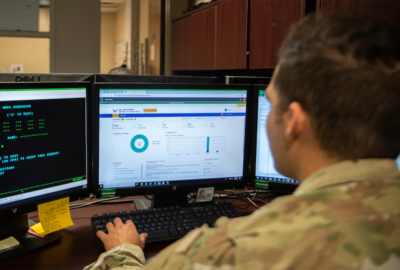
New jets, same old mistakes in Air Force purchasing
The Defense Department is in the midst of an acquisition program for a new fighter jet — an extensively modified version of the F-15, known as the F-15EX.
Best listening experience is on Chrome, Firefox or Safari. Subscribe to Federal Drive’s daily audio interviews on Apple Podcasts or PodcastOne.
The Defense Department is in the midst of an acquisition program for a new fighter jet. Actually it’s an extensively modified version of an old warhorse, the F-15, known as the F-15EX. Dan Grazier said the plane may be mostly new, but the Air Force is making some old mistakes in buying it. He is a military fellow at the Project on Government Oversight, and he joined the Federal Drive with Tom Temin.
Interview transcript:
Tom Temin: Dan, good to have you back.
Dan Grazier: Hey, good morning Tom. It’s great to be here.
Tom Temin: Alright, so that F-15EX, what is it exactly? And then we’ll get into what mistakes you think they’re making in how they’re acquiring it.
Dan Grazier: Sure. So the F-15EX is a latest generation version of the proven and veritable F-15 fighter. First started development in the 1960s, largely procured in the 1970s and 80s. It has been continually upgraded and modified over the years. And so the F-15EX is just the latest version of the aircraft. It’s what the Air Force is calling a fourth-gen-plus aircraft.
Tom Temin: Alright. And as we know, these major overhauls are almost all new, except for maybe the shell. And so that means that they have to treat it as new, but it sounds like they’re assuming a lot in the way they’re buying it. What is the acquisition plan? And we’ll start there, what are they doing?
Dan Grazier: So Pentagon leaders over the last 15, 20 years or so have come up with varying schemes to avoid the major defense acquisition process, that’s the the top tier major defense programs like the F-35 and the other key marquee weapons programs are acquired under that. But what Pentagon leaders have been doing is they’ve come up with a whole series of schemes to avoid the MDAP process, to avoid a lot of the oversight steps and reviews that go along with them. So the F-15EX is being dubbed a middle tier acquisition program. And that provides the Air Force the justification, I suppose, to avoid a lot of those usual overstep functions.
Tom Temin: So their assumption is that we’ve been buying this thing since the 1960s, we can speed it up for the EX version.
Dan Grazier: Right. That’s the justification that they’re giving. But the F-15EX program does meet the legal threshold to be a major defense acquisition program. So federal law mandates that any program that has a research development test and evaluation anticipated cost more than $525 million is the major defense acquisition program. And the program just in the F-15EX program just in FY 2020 and 2021, the research development test evaluation cost are almost $600 million.
Tom Temin: Yeah, so real money there. And we should point out to that you worked on this project with someone formerly in the Pentagon, who knows all about RTD&E.
Dan Grazier: Right. So this specific piece was primarily drafted by Mr. Tom Christie, who was the Director of Operational Test and Evaluation in the early 2000s, during the first term of the George W. Bush administration.
Tom Temin: Got it. When they were still buying F-15s back then, too.
Dan Grazier: Right. They were just starting the F-35 program at that point.
Tom Temin: And just briefly, what is the EX do that the older ones don’t do?
Dan Grazier: The F-15EX is going to have an updated suite of defensive and offensive combat systems. So it’s designed to allow the F-15, one, to continue flying on for another couple of decades, but also to deal with a lot of the modern enemy air defense systems.
Tom Temin: Got it. We’re speaking with Dan Grazie, military fellow with a Project on Government Oversight. And the report says that the development tests are done by engineering test pilots on behalf of the developer, that would be Boeing, to uncover any deficiencies, their aims are often incompatible with operational testing, which is done on behalf of the combat user. So it sounds like there’s a conflict of interest maybe built into the way they’re going about this parallel of testing and development.
Dan Grazier: Very much so. There are two distinct testing processes that need to happen with each weapon system as it’s going through the acquisition process. So developmental testing, they’re essentially laboratory tests. And they’re to make sure that the contractor delivered a product that meets the contract specifications. So if one of the contract specifications was to make sure that the aircraft could achieve Mach 1.8, then developmental test pilots are going to fly the plane up to that speed and mark on their checklist that it can achieve that speed. Same thing with a flight ceiling, supposed to fly to 40,000 feet, they’re going to fly it up to 40,000 feet. But they’re very kind of rigid checklist type items that a test pilot flies. Now operational testing, you take the production representative articles, so a product that has been fully developed and is ready to go into production, and you give that in the hands of actual real fighter pilots in the case of a plane, and then they take it up and they fly it around the way they would fly it in combat to make sure that it’s actually effective. So it goes far beyond just meeting basic contract specifications. But then they’re also in operational testing, they’re testing two things. They’re making sure that, yes, the fighter pilots can fly it the way that it needs to be flown in combat. So they’re checking for operational effectiveness. But then they’re also checking for operational suitability. So they want to make sure that this product actually works in the hands of all the operators. So in the case of a plane, not just in the hands of the pilots, but also in the hands of the maintainers, because anybody who’s ever done any work on a car is probably cursed an engineer at some point when a bolt is right up against the firewall, and you can’t get the wrench on it. Well, those are the kind of things that they’re checking in operational testing, just to make sure that you can swap out an engine properly in the field, that they can check all the POLs, the petrol, oil and lubricants the right way. So it’s very different processes, and they’re distinct. And when they’re done together, then the lines are blurred and it actually — our concern is that it’s going to water down independent operational testing.
Tom Temin: Right. So that to use your example, if it can reach Mach 1.8 in the vendor test, what a operational pilot would do is well, can it go that fast for more than 10 feet and change directions, and then fire a weapon at that speed or something. And then when it lands, you won’t find three things warped out of shape, because it went that fast for 50 miles instead of 10 feet.
Dan Grazier: Right. It’s an evolved process. And our concern is that — well, so the Office of Director of Operational Test Evaluation was created in 1983, and it was created over very vigorous objections of the defense industry, and certain service leaders, many of whom went on to work for the defense industry, because they wanted to be able to basically write their rules and be able to say whatever they wanted about the performance of these weapons. And so Congress created this office because they wanted to make sure that they were getting independent review of the effectiveness and suitability of these systems. And ever since the office was created in 1983, there have been efforts to either do away with the office, do away with reports or water down the process. And combining developmental testing and operational testing is just one of the latest efforts to water down independent operational testing.
Tom Temin: Alright. So then the consequences then could be that what — that the troops, the fliers, the Air Force members would receive something that is not fully ready for operational combat?
Dan Grazier: Right. Or it just doesn’t work. And let’s go to the most recent example, the F-35 program. It’s one where because of concurrency, because we started buying hundreds of F-35s before the operational testing process has been completed, and it’s still not complete, and we don’t even have a date when F-35 operational testing will be complete, you end up buying hundreds of aircraft with serious design flaws. And a really good example, just to the operational suitability issue, the autonomic logistics information system for the F-35 program, it’s a key part of the whole program, and the the train had left the station a long time before people realized that that aspect of the program didn’t work. And so now we have to spend even more money to develop a new system and try to make it backwards compatible with all the aircraft that have already been purchased.
Tom Temin: Yeah, they call that Alice in Wonderland is what I’ve heard of that particular system. Alright, so this is the road that they’re on thoughfor the F-15EX. And it looks like they’re just going to go ahead with the plan as they have it.
Dan Grazier: Yeah, they’re pushing forward the plan as it is. We’re trying to raise awareness of this because it’s a dangerous precedent. With the F-15 program, we are at least dealing with a solid foundation, because the F-15 is a proven system. Now a lot of the subsystems that are going to be included in this have yet to be designed, and have yet to be incorporated in the design, which further weakens the operational testing plan that they have now because they’re going to conduct operational tests with an underdeveloped system. But we’re really looking forward to future programs because we now have the B-21 program coming up. That’s going to start flying before too long, and it’s gonna have to go into operational testing, and we’re already talking about the next generation air dominance program. So there’s new systems on the horizon, and it’s important to make sure that independent operational testing is protected and it goes forward because if it’s not, we’re gonna end up with more F-35 like fiascos.
Tom Temin: Dan Grazier is a military fellow with the Project on Government Oversight. As always, thanks so much.
Dan Grazier: Hey Tom, it’s my pleasure to be here.
Copyright © 2025 Federal News Network. All rights reserved. This website is not intended for users located within the European Economic Area.
Tom Temin is host of the Federal Drive and has been providing insight on federal technology and management issues for more than 30 years.
Follow @tteminWFED





